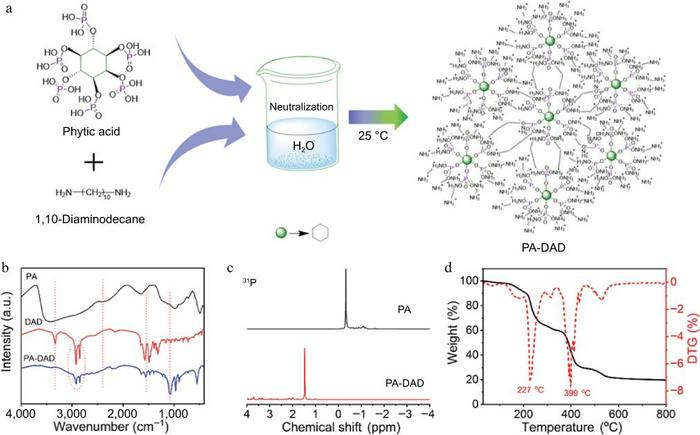Epoxy resin (EP), widely used in applications such as adhesives, coatings, and composites, is challenged by its inherent flammability and dense smoke production, which pose threats to safety and property. Enhancing flame retardancy is, therefore, critical.

(a) Schematic diagram for the prepared processing of PA-DAD, (b) FTIR spectra of DAD, PA and PA-DAD, (c) 31P NMR curve of PA-DAD and PA, (d) TG curves of PA-DAD. Image Credit: Emergency ManagementScience and Technology
Although a variety of flame retardants (FRs) exist, most are derived from non-renewable sources, conflicting with sustainability objectives. Recent interest has turned towards bio-based FRs like phytic acid (PA) for their renewable, abundant, and biodegradable qualities.
PA, in particular, is notable for its high flame-retardant efficiency due to its significant phosphorus content. However, the integration of bio-based FRs still faces hurdles, as some depend on petroleum-based products to achieve the desired effectiveness.
On November 26th, 2023, Emergency Management Science and Technology published a research study titled “A bio-based hyperbranched flame retardant towards the fire-safety and smoke-suppression epoxy composite.”
This study describes the unique invention and extensive characterization of PA-DAD, a totally biological flame retardant produced by a simple neutralization reaction between 1,10-diaminodecane (DAD) and PA.
Fourier-transform infrared spectroscopy (FTIR), nuclear magnetic resonance (NMR), and differential scanning calorimetry (DSC) investigations validated the effective synthesis of PA-DAD, revealing alterations in chemical bonding that suggest flame retardant production.
This bio-based flame retardant was then added to EP composites to study its effect on flame retardancy and mechanical qualities. The inclusion of PA-DAD significantly raised the limiting oxygen index (LOI) values and UL-94 ratings of the EP composites, demonstrating its value when it comes to increasing fire resistance.
Thermogravimetric analysis (TGA) and cone calorimetry tests have further demonstrated that PA-DAD enhances char yield while lowering the peak heat release rate (pHRR), total smoke production (TSP), and toxic gas emissions during combustion. These findings underscore PA-DAD's superior effectiveness as a flame retardant.
The development of a dense, intumescent char layer by PA-DAD serves as an effective thermal barrier, limiting both heat and mass transfer during combustion. This process involves the decomposition of PA-DAD into compounds that contain P-O-C and PO·, as well as NH3. These compounds are capable of neutralizing active H· and OH· free radicals, effectively reducing the release of oxygen and toxic gases.
This mechanism also hinders the ongoing degradation of the material it protects. Additionally, the research delved into the mechanical properties of EP composites, observing improvements in tensile, flexural, and impact strengths following the incorporation of PA-DAD. These enhancements are attributed to the increased crosslink density and the energy dissipation capacity of the ion bonds created by PA-DAD.
In summary, PA-DAD stands out as a highly effective and eco-friendly flame retardant, significantly improving the fire safety characteristics of EP composites while also maintaining or enhancing their mechanical performance.
This research highlights the promising role of bio-based materials in fire safety applications and opens new pathways for the development of sustainable, high-performance flame retardants.
The results offer considerable implications for future endeavors in producing safer and more environmentally conscious fire-retardant materials, representing a significant advancement in the field of materials science and engineering.
Journal Reference:
Lin, Z., et. al. (2024) A bio-based hyperbranched flame retardant towards the fire-safety and smoke-suppression epoxy composite. Emergency Management Science and Technology. doi:10.48130/EMST-2023-0021